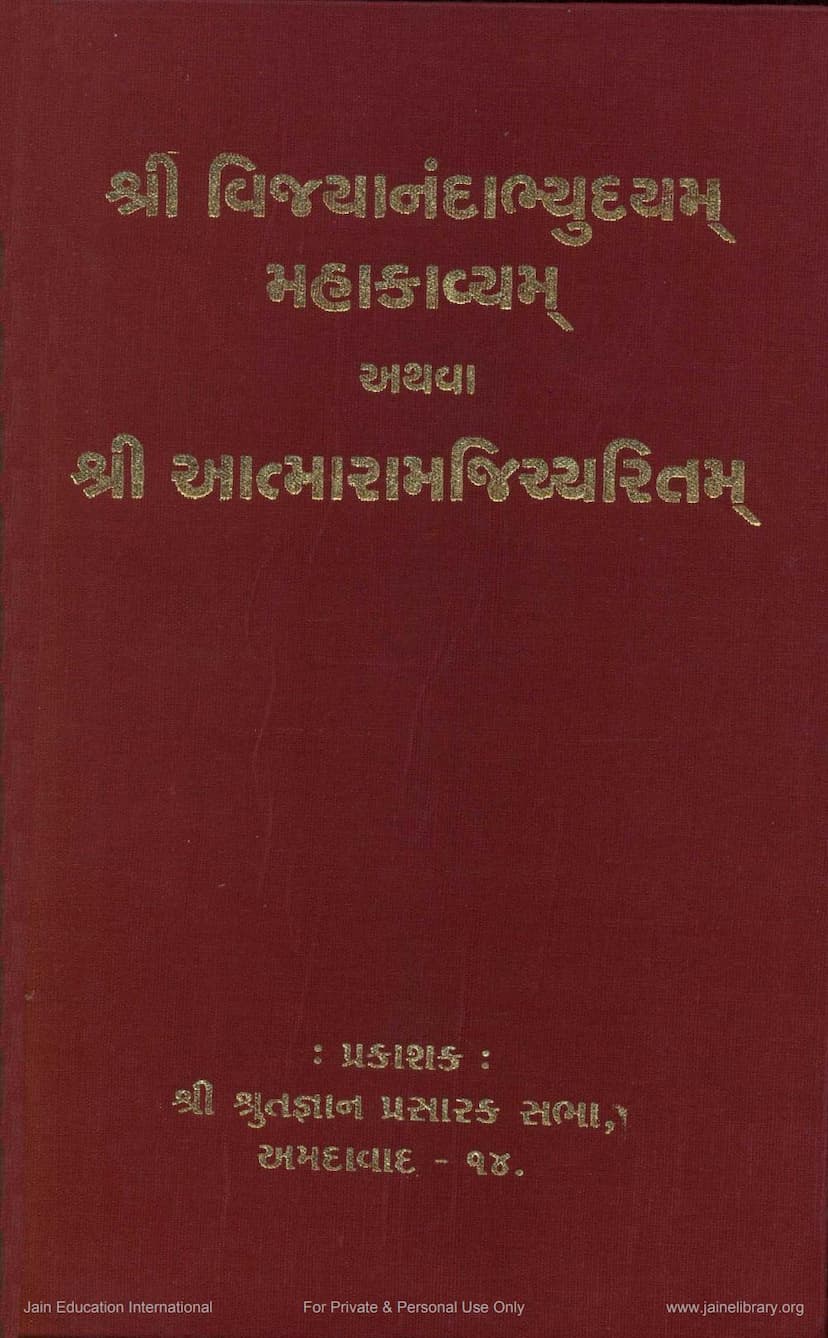Vijayanand Abhyudayam Mahakavyam Athwa Atmaramji Charitam
Added to library: September 2, 2025

Summary
Here's a comprehensive summary of the Jain text "Vijayanand Abhyudayam Mahakavyam athwa Atmaramji Charitam" by Hiralal Hansraj, based on the provided pages:
Book Title: Vijayanand Abhyudayam Mahakavyam athwa Atmaramji Charitam Author: Pandit Shravak Hiralal V. Hansraj (Jamanagar-based) Publisher: Shri Shrutgyan Prasarak Sabha, Ahmedabad Published: Samvat 1956 (1900 CE) Reprint: Samvat 2064 (2008 CE)
Overall Summary:
This extensive work, Vijayanand Abhyudayam Mahakavyam (also known as Shri Atmaramji Charitam), is a Mahakavya (epic poem) in Sanskrit, composed by Pandit Hiralal Hansraj. It chronicles the life and deeds of Acharya Shri Vijayanandsuri, widely revered as Shri Atmaramji Maharaj. The Mahakavya aims to preserve the memory and glorify the immense contributions of this prominent Jain scholar and religious leader of his time.
Key Aspects and Content:
-
Tribute to Acharya Shri Atmaramji: The primary purpose of the Mahakavya is to immortalize the life and preachings of Acharya Shri Atmaramji. The author, Hiralal Hansraj, expresses deep admiration for the Acharya's scholarly prowess, his dedication to spreading Jain dharma, and his ability to win over even Western scholars with his profound knowledge.
-
Global Influence: The text highlights Acharya Shri Atmaramji's significant impact beyond India, particularly mentioning his invitation to the World's Parliament of Religions in Chicago, America. Although he couldn't attend due to the restrictions of Jain monastic conduct, he sent Shri Virchand Raghavji Gandhi in his stead, contributing to the spread of Jainism there. The text quotes an English passage from the Chicago Parliament's report recognizing him as the "high priest of the Jain Community" and the "highest living authority on Jain religion and literature by oriental scholars."
-
Scholarly Contributions: Acharya Shri Atmaramji is credited with authoring numerous influential Jain scriptures, including Jain Tattvadarsh, Tattvanirnayprasad, and Ajnan Timir Bhaskar. These works are described as being filled with logic and justice, attracting scholars from other religions to Jainism.
-
Conversion and Impact: The Mahakavya states that Acharya Shri Atmaramji initiated approximately six thousand individuals into the pure and ethical Jain dharma. His writings and teachings had a profound impact on various scholars, including a notable incident involving a Sanyasi (ascetic) who, after reading Acharya Shri Atmaramji's works, wrote a letter praising him and composing a 51-stanza poem in his honor. The text includes a portion of this letter and the poem in the Sanyasi's own words.
-
Praise for Jain Virtues and Sages: The initial chapters (Sargah 1-4) contain extensive praise for the Tirthankaras (Jinas), including Shri Nabhiraja, Shri Shantinath, Shri Neminath, Shri Parshvanath, and Shri Mahavir. There is also a significant portion dedicated to the virtues of 'Sajjan' (good people) and the condemnation of 'Durjan' (wicked people), using various metaphors and analogies from nature and daily life to illustrate these points. The author emphasizes the importance of good company and virtuous conduct.
-
Narrative of Atmaramji's Life (Implied): While the initial Sargas focus on foundational Jain principles and praise for past Tirthankaras and virtues, the later Sargas (starting from the description of Panchal Desh and the story of Nala and Damayanti in the 7th Sargah) gradually build towards the narrative of Acharya Shri Atmaramji's life. The author details his birth, upbringing, spiritual awakening, intellectual development, his debate with the Dhundhak sect, and his extensive travels and preaching.
-
Detailed Descriptions: The Mahakavya provides rich and descriptive accounts of various subjects, including:
- Geographical descriptions: Jambudvipa, the ocean, Mount Meru.
- Saints and their qualities: Glorification of learned scholars, saints, and the author's gurus.
- Critique of heresy: Strong condemnation of the Dhundhak sect's practices and beliefs, highlighting their deviations from core Jain principles.
- Virtues and Vices: Extensive praise for virtues like sincerity, kindness, and righteousness, and strong critique of vices like greed, deceit, and hypocrisy.
- The story of Nala and Damayanti: Used as an example to illustrate the devastating consequences of gambling and addiction, a major theme in Acharya Shri Atmaramji's teachings.
- The plight of the soul in Samsara: The text often uses allegorical language to describe the soul's journey through the cycle of birth and death and the path to liberation.
- The importance of spiritual knowledge: Emphasis on acquiring knowledge, especially through the study of scriptures and under the guidance of a Guru.
-
Literary Style: The Mahakavya is written in Sanskrit with a poetic and elaborate style, employing various literary devices and figurative language. The author, Hiralal Hansraj, explicitly mentions his own limitations but dedicates himself to this task inspired by his gurus.
-
Genealogy: The text includes a genealogical chart of the author's family, tracing their lineage back to Shri Hansraj and his ancestors, indicating a learned and respected family background.
Significance:
- Preservation of History: The Mahakavya serves as a vital historical document, preserving the legacy of a pivotal figure in Jain history.
- Spiritual Guidance: It offers spiritual and ethical guidance through the life story and teachings of Acharya Shri Atmaramji, emphasizing core Jain values and practices.
- Literary Merit: As a Mahakavya, it contributes to Jain literature with its extensive Sanskrit poetry and detailed descriptions.
- Interfaith Understanding: The mention of his international influence and interactions with scholars of other faiths highlights the potential for interfaith dialogue and understanding facilitated by Jain scholars.
In essence, Vijayanand Abhyudayam is a monumental tribute to Acharya Shri Atmaramji, showcasing his multifaceted genius as a scholar, preacher, reformer, and spiritual leader who significantly contributed to the propagation and preservation of Jain dharma.